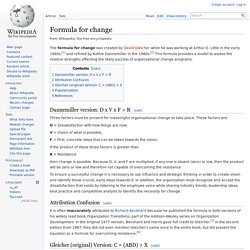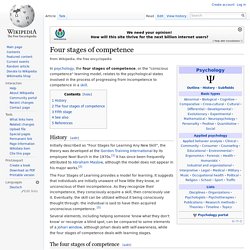

Formula for Change. The formula for change was created by David Gleicher while he was working at Arthur D.

Little in the early 1960s,[1] and refined by Kathie Dannemiller in the 1980s.[2] This formula provides a model to assess the relative strengths affecting the likely success of organisational change programs. Dannemiller version: D x V x F > R[edit] Three factors must be present for meaningful organizational change to take place. These factors are: D = Dissatisfaction with how things are now; V = Vision of what is possible; F = First, concrete steps that can be taken towards the vision; If the product of these three factors is greater than R = Resistance then change is possible. To ensure a successful change it is necessary to use influence and strategic thinking in order to create vision and identify those crucial, early steps towards it.
Attribution Confusion[edit] Gleicher (original) Version: C = (ABD) > X[edit] The original formula, as created by Gleicher and published by Beckhard,[5] is: Learning styles. Learning style is an individual's natural or habitual pattern of acquiring and processing information in learning situations.

A core concept is that individuals differ in how they learn.[1] The idea of individualized learning styles originated in the 1970s, and has greatly influenced education.[2] Proponents of the use of learning styles in education recommend that teachers assess the learning styles of their students and adapt their classroom methods to best fit each student's learning style. Although there is ample evidence for differences in individual thinking and ways of processing various types of information, few studies have reliably tested the validity of using learning styles in education.[2] Critics say there is no evidence that identifying an individual student's learning style produces better outcomes.
David Kolb's model[edit] David A. David Kolb’s Experiential Learning Model (ELM) [5] 1. 2. 3. 4. Learning Modalities[edit] 1. 2. 3. Descriptions of Learning Modalities: 1. 2. 3. Four stages of competence. In psychology, the four stages of competence, or the "conscious competence" learning model, relates to the psychological states involved in the process of progressing from incompetence to competence in a skill.

History[edit] The Four Stages of Learning provides a model for learning. It suggests that individuals are initially unaware of how little they know, or unconscious of their incompetence. As they recognize their incompetence, they consciously acquire a skill, then consciously use it. Eventually, the skill can be utilized without it being consciously thought through: the individual is said to have then acquired unconscious competence. [3] Several elements, including helping someone 'know what they don't know' or recognize a blind spot, can be compared to some elements of a Johari window, although Johari deals with self-awareness, while the four stages of competence deals with learning stages.
The four stages of competence[edit] Fifth stage[edit] Depressive realism. Evidence for[edit] Evidence against[edit] When asked to rate both their performance and the performance of another, non-depressed individuals demonstrated positive bias when rating themselves but no bias when rating others.

Criticism of the evidence[edit] Some have argued that the evidence is not more conclusive because there is no standard for "reality," the diagnoses are dubious, and the results may not apply to the real world.[33] Because many studies rely on self-report of depressive symptoms, the diagnosis of depression in these studies may not be valid as self-reports are known to often be biased, necessitating the use of other objective measures. Due to most of these studies using designs that do not necessarily approximate real-world phenomena, the external validity of the depressive realism hypothesis is unclear.